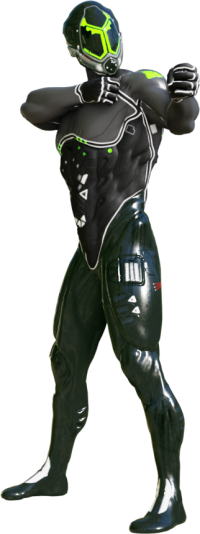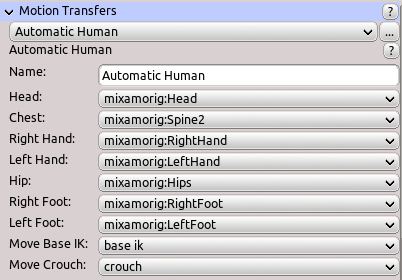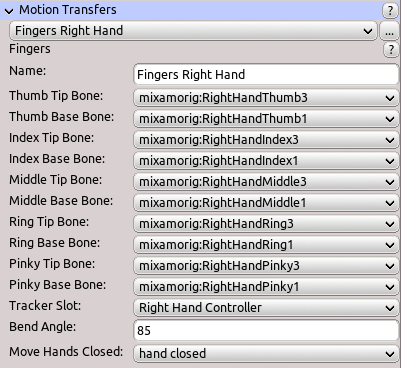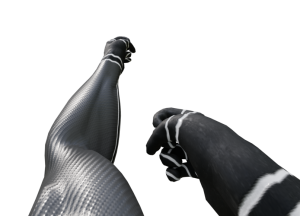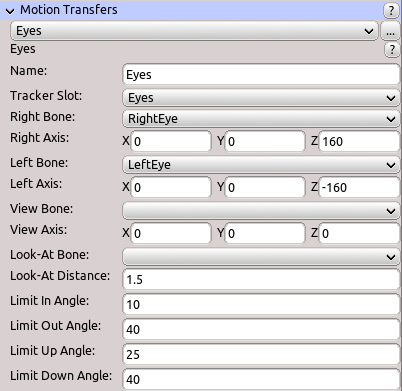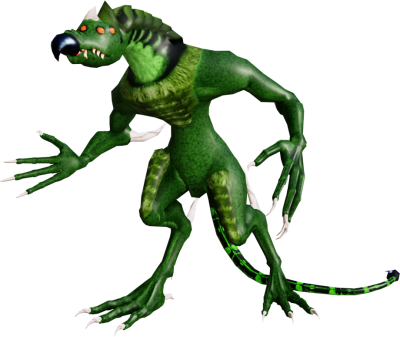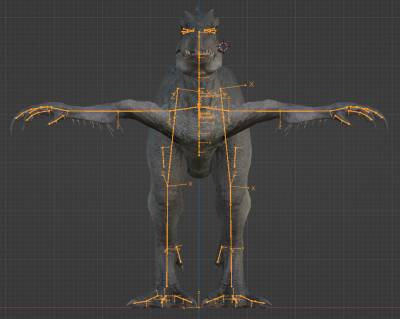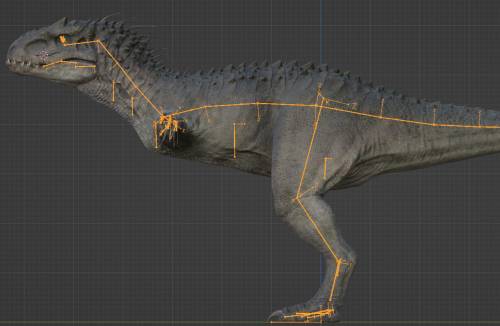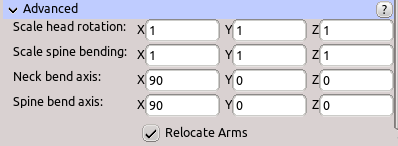Table of Contents
Start Page » DEMoCap: Drag[en]gine Motion Capture » Example Characters
DEMoCap contains a couple of example characters demonstrating various setups difficult or impossible to handle with existing motion capture systems. The example characters are configured out of the box for motion capture so you can activate them, calibrate them and get started. The configuration steps outlined in the description are for your information on how you would have to approach a character of your own matching the example character in body posture and required features.
The Shadrian character model is copyright DragonDreams GmbH. The Bio-Mech, Dragonroo and Indominus Rex characters are models freely available on the internet under Creative Commons type license. Please see the attribution file to learn about the original creators.
Bio-Mech
The Bio-Mech example character is a typical humanoid character to motion capture.
The proportions of such characters are similar or nearly identical to the proportions of the motion capture actor. These kind of characters produce the best results since the motion of the actor maps pretty much 1-on-1 to the character. These kind of characters need the least amount of setup and tuning. The automatic placement of tracker slots is usually correct and does not need tweaking.
The Bio-Mech example character supports full body capturing and finger capturing. It contains an Auto Human motion transfer for full body motion capture and two Fingers motion transfer to capture fingers on the right and left hand.
The basic setup looks like this:
Assign the appropriate bone to the Auto Human motion transfer. For the animation moves assigned for best capturing see Create Character Tutorial.
The setup for the finger bending also requires assign the bone chains for each finger as well as the animation move used to curl the fingers. Using an animation move gives better results than using a fixed angle.
First Person Hands
The First Person Hands example character is the Bio-Mesh example character minus the body. This is a typical setup for first person shooter games where only the arms are visible.
The proportions of such characters are usually similar to the proportions of the motion capture actor. Sometimes though the in-game arms are longer or shorter depending on the view of view used for the camera and game-play considerations.
First person view characters typically differ from full body characters in that the arms model is centred around the origin of the model instead of the upper chest area. To do successful motion capture with such a model you have to provide a calibration move which places the arms at the correct shoulder level. You should be able to simply move the origin bone up to shoulder level and it should work for motion capture.
The First Person Hands example character supports upper body capturing and finger capturing. It contains an Auto First Person View motion transfer for upper body motion capture and two Fingers motion transfer to capture fingers on the right and left hand.
The configuration of the Auto First Person View motion transfer is similar as with the Bio-Mech example character but has less bones to assign.
Dragonroo
The Dragonroo example character is a typical example of a beast type character with humanoid posture. Such characters typically have bend legs (or beast legs), disproportional bodies with short or long necks and additional limbs like tails, wings or multiple arms.
For such characters the virtual camera is attached to the character head. Due to this the head movement as seen by the motion capture actor is different from his own head movement. The longer the neck of the character the faster the virtual camera moves. Motion capture actors tackling a character with long neck for the first time should start with slow head movement to get used to the amplified head movement.
The Dragonroo character has bend legs, a longer neck compared to a human character and a tail. The arms are slightly shorter than regular human arms. The basic setup is the same as for the Bio-Mech example character but requires the tracker slots to be moved.
The tail of the character is befitted with physics parameters to simulate a soft tail (dragging along the ground). The physics parameters are stored in the rig file (dragonroo.derig) as well as in the blend file (dragonroo.blend). While exporting the character the physics parameters (done using blender physics tab) are written to the rig file. This is the easiest solution that works best with existing work flows where the source file is a blender file.
The Dragonroo example character supports full body capturing, finger capturing, facial capturing and physics tail capturing. It contains an Auto Human motion transfer for full body motion capture, two Fingers motion transfer to capture fingers on the right and left hand, an Eyes motion transfer to capture eye movement and a Face motion transfer to capture mouth movement.
For the eye tracking use a setup like this. Assign the bones used for the eyes and set the limits. The limits indicate how far the eyes can rotate horizontally and vertically. Use blender to figure out what rotation limits work best for your model. The view bone and look-at bone are optional and typically do not deform the model. They can be used to drive in-game logic by knowing where an actor looks at during the course of an animation.
The Dragonroo character contains also a full set of facial expressions using Vertex Position Sets. The blend file contains Shape Keys for each facial expression. These can be exported to the model and animation file (*.deanim). To do this select the dragonroo model and export the animation. If you select the armature instead shape keys are not exported. In the Face motion transfer panel you have then to set assign the move names to each supported facial expression. There are many expressions grouped by facial areas. See Facial Expressions for the full list of supported expressions.
Shadrian
The Shadrian example character is a typical example of a beast type character similar to the Dragonroo example character but it has a higher degree of non-humanoid posture.
The Shadrian example character has bend legs, a long neck and a tail. The setup is similar to the Dragonroo example character concerning the body and tail but differs in terms of neck. Since the neck is long the virtual camera movement as seen by the motion capture actor is faster. Motion capture actors tackling a character with long neck for the first time should start with slow head movement to get used to the amplified head movement. Also the arms and fingers are much longer than a regular human.
Furthermore the Shadrian example character contains two configurations. The first configuration uses regular head movement as used by the other example characters. The second configuration uses Overarching Head Movement. With this configuration the head movement of the motion capture actor is amplified. In the case of the Shadrian example character this is a factor of 1.5 . Hence the head movement by the character is 50% stronger/faster than the head movement of the motion capture actor. This allows to character to rotate his neck much farther to look backwards and doing all kinds of extreme looking directions. Think of an own character able to rotate his head all the way backwards. Using Overarching Head Movement this can be achieved with the motion capture actor turning his head only in comfortable ways.
The Shadrian example character supports full body capturing, finger capturing and physics tail capturing. It contains an Auto Human motion transfer for full body motion capture and two Fingers motion transfer to capture fingers.
The first setup with regular head rotation uses factor 1 for each direction in the Auto Human motion transfer.
The second setup with overarching head rotation uses factor 1.5 for each direction. In general a value around 1.5 work best. Values around 2 allow the character to turn the head all the way backwards and also somewhat beyond. This can lead to problems if looking up or down beyond the pole position. You can use a large value for Y axis (horizontal rotation) and lower values for X and Z axis (vertical and tilting). Using non-uniform scaling for the axes can make it though difficult to properly hit a desired movement. You can also use different values for head and spine rotation. Head rotation is driven by your head movement while spine rotation is driven by your upper body bending (if a chest tracker is used). Using different values for head and spine rotation can be difficult to handle. Experiment with the values to figure out which configuration works best for your motion capture actor.
Indominus Rex
The Indominus Rex example character is a typical example of a quadruped beast type character. These characters are difficult to handle since the upright posture of the motion capture actor is translated to a vertical quadruped stance. Characters of this kind require more time to set up and tweak to others.
The Indominus Rex example character is a very large character. For this reason head movement is fast due to the long reach of the neck. Motion capture actors tackling this character should first start with slowly moving the head until they get a feeling for the large size of the character.
The Indominus Rex example character has bend legs, a long neck, a tail and a vertical stance. The setup is similar to the Dragonroo example character but requires special attention to the arms. In general the placement of the tracker slots is the same as with the other characters. Place the hand, elbow and chest slots as outlined in the Create Character Tutorial. For this to work properly the calibrate animation move has to be in the vertical stance but the arms held in T-pose. The resulting animation move has to look like this:
The Indominus Rex example character supports full body capturing, finger capturing, physics tail capturing, eye and facial capturing. It contains an Auto Human motion transfer for full body motion capture and two Fingers motion transfer to capture fingers.
The tail physics is similar to the Dragonroo character but the stiffness is set high to keep the tail lifted off the ground and bouncing like held in place by strong muscles.
The Auto Human motion transfer is set up similar to the other characters but needs a special setting to handle the arms located in front of the body instead of above the hips. Enable the Relocate Arms property to make the arms movement to be properly relocated in front of the body.
The motion actor can now keep the arms down in front of his body to obtain the typical T-Rex hand position and act with an upright stance while the character keeps a horizontal posture. By bending forward and backwards the actor can then make the characters body bend upwards and downwards. By bending left and right actor can make the characters body twists left and right (hip-arms axis). By turning the body left and right the actor can make the character bend left and right. This allows natural movement of the body lining up with the actors natural movement.
The Indominus Rex example character also shows how hand positions can be done which are awkward for an actor to perform. The Indominus Rex character has the back of the hand facing upwards in the natural position. An actor has the back of the hand facing outwards (90 degrees to the right for the right hand) if held in front of his body. This is also the hand pose used for calibrating. To avoid forcing the actor to twist his hand to achieve the neutral hand pose of the character the hand needs to be properly oriented in the calibrate animation move. See the hands in front shot image above. For regular characters the back of the hand would be facing backwards so you would see the palm of the hand. For the Indominus Rex character the back of the hand is facing upwards exactly how the hand is held in the neutral pose of the character. If done this way the motion capture actor can hold the hands comfortably in front of his body to obtain the neutral pose of the character. Twisting the hands left and right maps then correctly to the character twisting the hands left and right.
Since the hand is 90 degrees rotated the motion capture actor has to perform hand movements differently. For example to create a side swiping attack with the claws the arms perform the motion as expected but the motion capture actor has to twist his hand sideways to make the character claws swipe in the right direction. Hence the actor performs the swipe with the fingers pointing up although the character swipes with the claws pointing inwards. You can rotate the hand in the calibrate animation move to make the acting as easy as possible for your motion capture actor.
The Indominus Rex example character has two configurations. The “AutoHuman” configuration uses actor scaling. This configuration uses scales the actor up to the size of the character. The “AutoHuman Small” configuration on the other hand uses character scaling. The character is scaled down to the size of the motion capture actor. In this configuration the character is roughly the size of a large dog.

